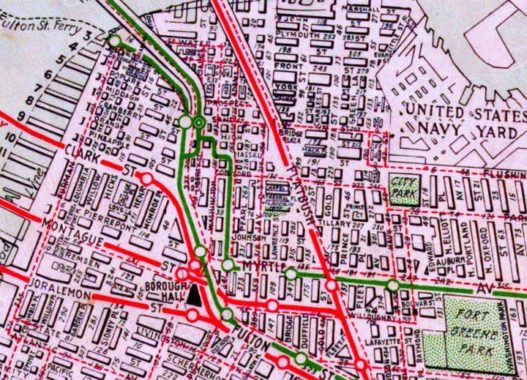Unlike Queens, which was in the midst of overhauling its street nomenclature in 1922, pushing out names and old numbered streets and instituting a borough-wide numbering system, the map of Brooklyn was pretty much settled on in 1922, and it would remain much the same to this day, with one glaring exception. While outlying regions such as Bergen Beach and Canarsie were not yet completely urbanized, and wouldn’t be until the late 20th Century, much of Brooklyn was laid out and built up.
The downtown area, though, has experienced great change since 1922. Public works by traffic czar Robert Moses such as the Brooklyn-Queens Expressway as well as Cadman Plaza, a large park, and housing such as the Farragut, Ingersoll and Whitman Houses, as well as private developments like MetroTech Center, have conspired to eliminate dozens of streets, hundreds of buildings, and two separate elevated train lines. A comparable situation took place in Boston, which tore out much of its downtown and Scollay Square area to build its City Hall and other government buildings in the 1960s. Downtown Brooklyn’s changes began in the 1940s and continue to this day.
On the 1922 map shown here the thick green lines represent elevated trains. One of them came over the Brooklyn Bridge and ran south on Adams Street and east on Myrtle Avenue. The Myrtle Avenue el would last until 1969. Another one, the Fulton Street El, began at the East River and ran east out on Fulton Street and Liberty Avenue to Ozone Park. The section shown here would be torn down in 1942. Not shown on this excerpt is a branch that went down Flatbush, 5th and 3rd Avenues into Bay Ridge, which ran until 1940. We can see a number of streets that exist as relative stubs today that ran full length in 1922, such as High (named for a hill leveled nearly two centuries ago), Johnson, Sands and Prospect Streets.
The north end of Fulton, and the south end of Washington, became Cadman Plaza East and West, while in the 1970s the north end of Cadman Plaza West was re-dubbed Old Fulton Street. When Cadman Plaza was built in the 1950s, the formerly el-shrouded Adams Street was given 6 extra lanes to carry traffic coming off the Brooklyn Bridge.
And alleys, alleys, alleys. DUMBO has lost a few, like Talman Street, Charles Street, Green Lane. There were tiny, narrow ones with not enough room to show on the map, like Floods Alley, Gothic Alley and Nutria Alley, the latter named for a fur-bearing critter prized for its fur. Newark has a Nutria Alley too, both are gone now.
Until recently, these were just lines on paper to me. But the city has now uploaded thousands of 1940 photos onto the Municipal Archive — just pick a street, and let the wonders show themselves. Here’s Adams Street, for example.
Years ago, I compiled a fairly comprehensive list, on FNY’s Downtown Brooklyn Street Necrology.
Check out the ForgottenBook, take a look at the gift shop, and as always, “comment…as you see fit.”
2/20/19
